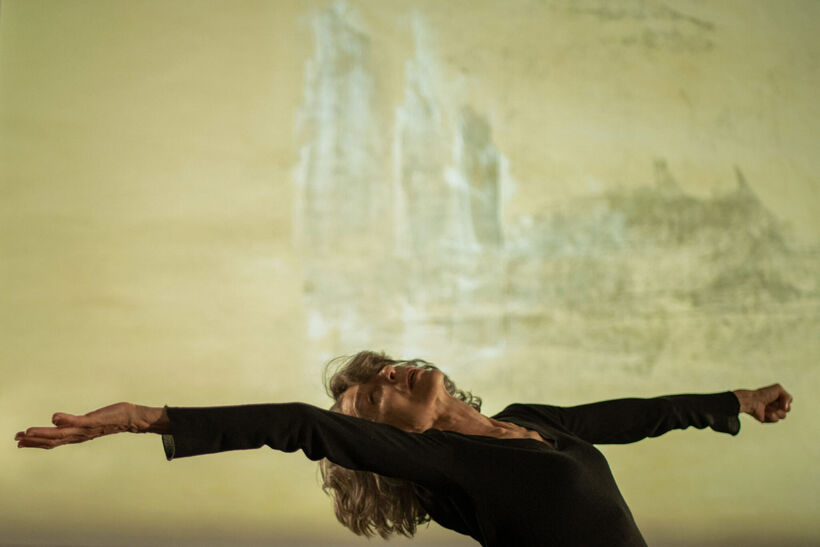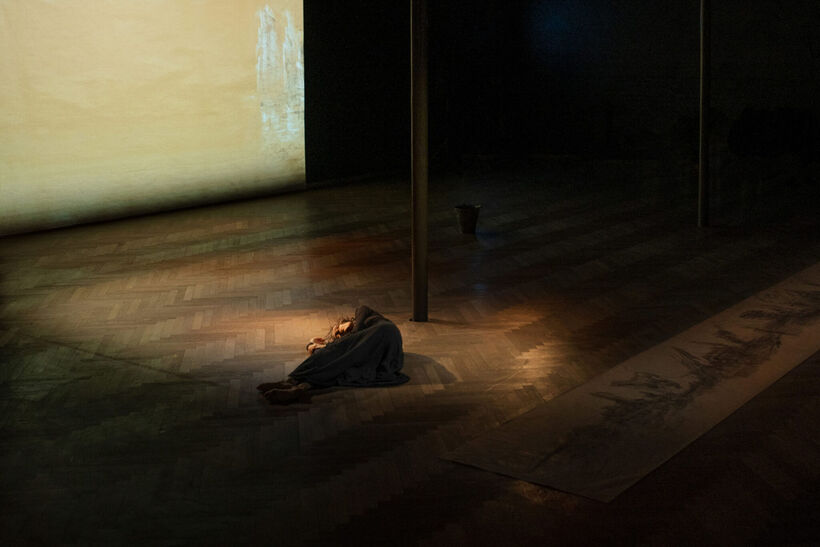Umwandlung – A Touching Testimony of the Body’s Force of Perseverance
On the evenings of the 29th and 30th June at the Montpellier Danse Festival, Anne Martin, Pina Bausch Dance Company soloist from 1979 to 1991 and later a teacher at CNSMD in Lyon, presented Umwandlung – her first solo dance piece at the tender age of 68. In a moment of inspired festival scheduling, later the same evening the Pina Bausch Dance Company performed the classic Palermo Palermo, creating a Bauschian double-header that challenged my impressions of the former piece.
When watching Martin’s work, I was constantly asking myself how to watch her performance in isolation, putting aside the obvious dance heritage she brings with her. I tried to absorb Martin herself, as she appears in her delicately personal yet powerful piece: as a multitude, as a metamorphosis of all the small pieces of her immense life, embodied through this multifaceted work.
“Traversée de tous ces souffles de vie, je ressens maintenant le désir impérieux de chercher de gratter de creuser plus profond… (…) Qu’est-ce que c’est ma danse, à 68 ans ?” (“Crossing all these breaths of life, I now feel the urge to seek to scratch, to dig deeper… (…) What is my dance, at 68?”) – asks Anne Martin in the performance programme.
Over the course of the mere 45 minutes Martin spends on stage, any comparison to her Pina-Bausch-past is forgotten. Through her performance, full of introspection and deeply intimate moments, we embark on a spiritual journey of destruction and regeneration, all while orthodox Slavic hymns and sounds of nature fill the air. Umwandlung signifies a change, a transition. At 68 years of age, the tall, slender figure standing in front of us has certainly lived through them before. Completely covered in a long, black dress with long sleeves, hers is a body that openly recounts the burden of the years that have passed. But her fingers floating in perfect circles around it seem to be driven by deeper forces. And from her solemn, dignified face and from eyes that sparkle with will and passion, her spirit wanders freely in front of our eyes. She is at once testimony to the passage of time and the perseverance and defiance that we all have within us, we who keep living, loving and dancing, against all odds, and in the face of all the tragedies, big and small, that mark our lives and our bodies.
A long canvas is spread on the floor in front of the audience and, on a large screen in the background, a video is slowly passing over an enlarged version of the same drawing, following vaguely figurative forms created by Gilles Nicolas. A village, and then a cityscape, seems to appear, and then trees… Or is it a mountain? We intuitively realise that when the video reaches the end of the canvas, the show is over. Like the thread of fate slowly being spun out, a show (and a life) measured and revealed.
Umwandlung touches different levels of our perception – visual, visceral, and corporeal. As the subtitle ‘dialogue avec l’absent’ suggests, the piece is a dialogue with her past. But the performance is also a statement about the life that still lies ahead. She constantly searches for something, strolling around on the stage in a dramaturgical structure that follows strict lines and geometrical rules. Incorporating incoherently coherent elements – the sounds of water droplets, bells, machines gnawing, Slavic chants, symbols of life and death – she forms a passage, a fluctuation of life. She steps into a purifying bath, creating a calligraphic dance by running her hands frenetically in a cleaning motion over her head, body, and stomach, but also over the back screen itself.
Martin’s movement path follows its own rhythm, at the beginning it is quick, agile, mostly oriented around hand movements, before continuing on the floor, crawling, and jumping in a frog-like manner, before arriving at a standing position, a corporeal renewal. In between the chants, a bell rings while she repeats movements of her hands from head to stomach, with the ash that she had previously spilled and now staining her dress like an open wound. It ends in spiritual regeneration, with Martin at the back of the stage proudly staring at her audience. With her arms stretched upwards and her biceps flexing, her breath forms a percussion beat to the choral chants. In the background, we hear fireworks.
Why fireworks, you may ask? And this might be where the piece seemed to miss the mark slightly. While the dramaturgical and choreographic structure is deliberate and fitting to the subject, it is not always as easy to discern the rationale of the sound elements. Why the sounds of rain in the beginning? (Considering the sounds of the elements seem to be ubiquitous to any contemporary dance piece, the answer seems to be… ‘Why not?’). And why the orthodox chants? Since they came rather out of the blue, and as I had no knowledge of any relationship between the artist and Eastern Europe, my mind immediately turned towards a certain war – which I am sure was not quite the intention. The chants were followed by the aforementioned fireworks, which themselves were not immediately distinguishable from the sounds of war and added to my temporary confusion.
These minor doubts do not, however, overshadow the sense of awe I felt in the presence of this truly charismatic, vital, and vibrant being. Her performance implored a singular imperative: Live, damn it!
Written from the performance of the 29th June 2023 at Agora, Montpellier Danse Festival, Montpellier.
Umwandlung (Dialogue avec l’absent)
Creation, choreography, dance: Anne Martin
Illustration: Gilles Nicolas
Lights: Rémi Nicolas
Costume: Julia von Leliwa
Sound: Thibault Cohade
Music: Arvo Pärt (Trivium extract), orthodox chants from the Valaam Monastery
Video: Jérémy Tran
Video assistant, sound engineer: Xavier Boyer
Production: Stéphane Marvy





